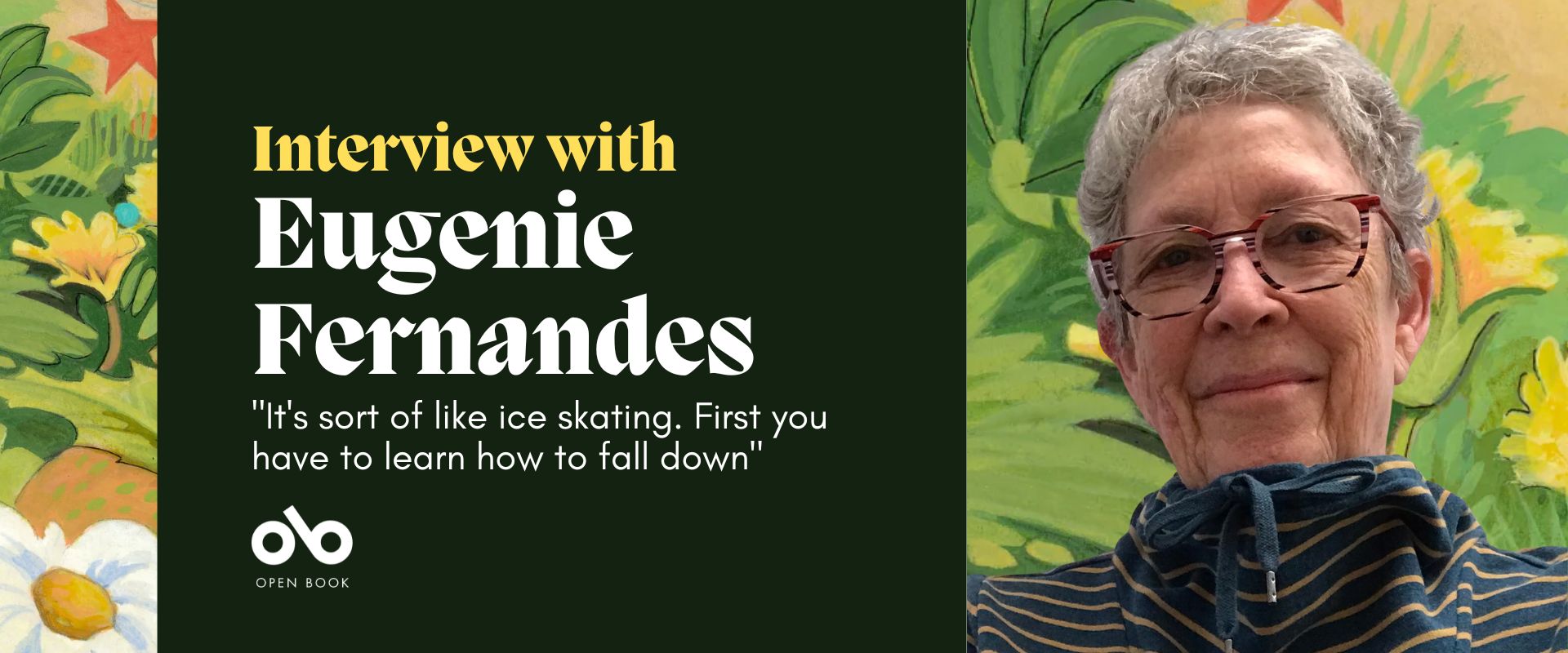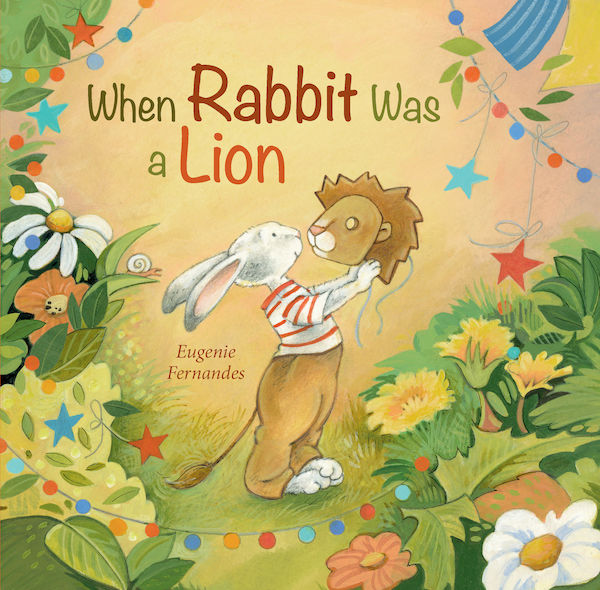Eugenie Fernandes on Breaking Down the Extrovert/Introvert Dichotomy in Her Lovable New Picture Book
In recent years, the idea of introverts (those who may enjoy social interactions but find them draining) and extroverts (those who gain energy from social interactions) has been everywhere, from online quizzes to news articles and even full-length books about how to work, date, and live as individuals at one end of the spectrum or the other.
In artist and children's book author Eugenie Fernandes' new picture book, When Rabbit was a Lion (Owlkids), Fernandes adds nuance to the idea of the polarity, showing how introverts can in fact deeply desire the company of loved ones and that no one is simply and consistently introverted or extroverted.
When the lovable, titular Rabbit announces he's throwing a costume party for all his friends, they're surprised because Rabbit doesn't like big, loud parties. But he loves his friends, and wants to see them. Even though the choice was his, he worries in the lead up to the party, and does, indeed, become overwhelmed when it swings into high gear.
But his friends notice when Rabbit slips away, and everyone compromises on ways to make sure not just Rabbit, but everyone, can have fun and feel included. A gentle tale about friendship, effective communication, and meeting our loved ones where they are, it also reminds kids—who are so often burdened with over-arching labels like "shy" or "wild"—that no one is just one thing.
We're speaking with Fernandes, the daughter of the late Golden Age comic artist Creig Flessel, about When Rabbit Was a Lion as part of our Kids Club interview series. She tells us about finding inspiration for Rabbit in her husband, what she's learned from illustrating over 100 picture books, and why she identifies as "an illustrator who also writes".
Open Book:
Tell us about your new book and how it came to be.
Eugenie Fernandes:
When I'm working , I am QUIET. No music. No radio. Just colours and stories filling my head. All day. Every day. By myself. Writing. Painting. I'm happy in my studio. Maybe I'm an introvert. But sometimes I venture out. Sometimes I'm an extrovert. My husband is a bona fide, content-with-who-he-is introvert. He was the inspiration for my newest book: When Rabbit Was a Lion (Owlkids Books)
The story is about a quiet rabbit who wants to have a party for his friends.
"But Rabbit," I said, "you don't like parties. You don't like crowds and loud noises."
"That's true," said the rabbit. "But I do like my friends."
So invitations were sent.
…
Finally, on Saturday, everything was ready, and the rabbit was pleased.
But then he got the jitters.
"What if I look silly in my costume? What if the party is a flop?"
"What if it's good?" I said.
Your CanLit News
Subscribe to Open Book’s newsletter to get local book events, literary content, writing tips, and more in your inbox
Not long after that, the rabbit's friends arrive looking splendid in their costumes. The party is LOUD and leaping, with uproarious laughter and babbling conversation. Rabbit is happy to see that his friends are happy. However, before long he is feeling overwhelmed. He slips away. Exhausted, he topples into the flower bed. When his friends find him there, looking sad and limp, they all agree to switch to gentler activities so that Rabbit can rejoin the party.
OB:
Is there a character in your book that you relate to? If so, in what ways are you similar to your character and in what ways are you different?
EF:
You might wonder if I base my characters on real people. Yes, sometimes I do. When I'm illustrating, I often create characters that look like friends or family members. In one of my stories, the main character looks like me and feels like my six-year-old-self.
In When Rabbit Was a Lion, the rabbit doesn't look like my husband, but he definitely has the same creative, low-key personality. And, like the rabbit, he does not like to show me his paintings until they are finished! I relate to the narrator in the story. She likes having a quiet breakfast in the back yard with the rabbit. But she can also join in with the swirling and twirling at the party. (I don't know if she actually likes wild parties. I do not.)
OB:
How do you cope with setbacks or tough points during the writing process? Do you have any strategies that are your go-to responses to difficult points in the process?
EF:
I have illustrated over one hundred picture books. Twenty-four of them were my own stories. So, I've had to learn to cope with tough points with illustrations as well as with words. I find that ideas are everywhere, floating around us all the time. Sometimes I hear words that sound like a title for a book. I'm still waiting to read The Wonderful Adventurous Coddiwomple. But that's just the idea. Turning the idea into a story... that takes "grit and determination and gumption and pizzazz... and the courage of spring and the colour of laughter." It's sort of like ice skating. First you have to learn how to fall down... and then, get up again.
Coping with changing illustrations and stories can be challenging... after all, I've probably already made a lot of changes myself in the process of creating them. But if I respect the editor and the art director, I listen to their suggestions. Most of the time I agree with them. Sometimes, it's six of one and half a dozen of the other. Sometimes I don't agree. Then I try to accommodate their ideas and work with them for a solution. Once, when I was illustrating one of my own stories, the editor wanted me to show sympathetic parents looking down at their very unhappy child. I felt that the child, having to choose between two kittens that she loved, would have gone off by herself to deal with her sadness. The art director and I tried three times to convince the editor to do it my way. But... no luck. Hmmm... what to do? Here's what I did. I painted the final illustration the way the editor wanted it. Then I painted it a second time the way I wanted it. I said nothing. I just delivered the final art with both versions. They said nothing. When the published book finally arrived, I was delighted to see that they had used my version of that illustration.
Three of my stories actually unfolded "fully formed", but I rarely get it right the first time. I completely re-wrote one of my story eight times (I really liked the idea). Three publishers later, it became a real book. When I get 'brain freeze'... I step away. Take a walk. Listen to the birds. Read Where the Wild Things Are. Have a cup of tea on the deck. Talk with a friend.
OB:
Do you feel there are any misconceptions about writing for young people? What do you wish people knew about what you do?
EF:
People often tell me that they would like to write a children's book. I think there's a misconception that it's easy. While it's not hard in some ways, you have to say a lot with very few words, clearly and with empathy and humor, and a sprinkling of adventure or a challenge of some sort to be overcome. (Maybe those are enough words about that.)
Somebody once said to me: "It's just a children's book. It's not as though it's War and Peace." Perhaps not... but I think it's pretty important for children to learn how to read! And to enjoy reading. And to be read to by someone who loves them.
Here's something I'd like you to know about my illustrations: I almost always have a visual story going on in the background. Maybe there's no mention of a cat in the text, but there's a cat in the pictures creating her own story. What is she doing? How is she reacting to things? In When Rabbit Was a Lion, there's a snail in every picture. Is it a very fast snail, keeping up with the rabbit? Or is it a different snail every time?
OB:
How would you describe the writing community in Canada in terms of authors writing for young people? What strengths and weaknesses do you observe within the community?
EF:
I have found the people involved in creating picture books for children to be talented, smart, courageous, and aware of the world around them. I've been a member of the Canadian Children’s Book Center since the early days. What a fabulous organization that is!! Being somewhat of an introvert, I never joined any of the other writer/illustrator organizations, but I think they're terrific. The community of authors and illustrators is enthusiastic, talented and supportive of each other. How great is that!
When I'm working on a story, I often ask writer friends and teacher friends to read the story out loud to me so I can hear how it sounds... to see if I have the rhythm of the words right. It's like music. I want it to get louder and softer, faster and slower.
Because I'm an illustrator who also writes, what I see in my head affects the words. When I'm illustrating a story written by somebody else, I appreciate it if they have a sense of what they are creating visually.
OB:
What are you working on now?
EF:
I have just finished the illustrations for a story about a lively dog (publishing in 2024). I'm just starting the pencils for a story about a boy with lively hair (publishing in 2025). These are both by other authors. Here's the title for my next as-yet-to-be-written story... NO GARLIC!
OB:
Is there a message you hope kids might take away from reading your book?
EF:
In When Rabbit Was a Lion, some of the characters are extroverts and some are introverts and some are a bit of both. It doesn't matter which one each one is. What matters is that they are kind and aware of each other's feelings, and that they accept each other as they are.
Some people like rock concerts and uproarious parties. Some people hate them. Some people like the music of birds and the ripple of waves on the beach. Which do you like?
__________________________________________________________
Eugenie Fernandes grew up painting with her father, comic-book illustrator Creig Flessel. Since graduating from the School of Visual Arts in New York City, she has written twenty five stories and illustrated over one hundred books for children, including the critically acclaimed Frogness and A Likkle Miss Lou. Having lived on islands all her life, Eugenie now lives and works on a small island in southern Ontario.





